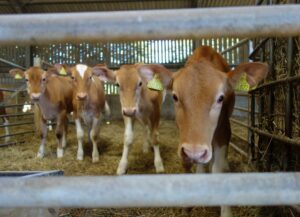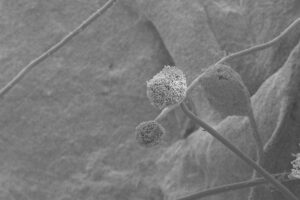Alvaro Garcia
The transition period of dairy cows is characterized by changes in behavior, hormonal patterns, and increased metabolic and nutrient demands. Cows in late gestation (2-3 weeks to calving) undergo changes in metabolism and a mismatch between dry matter intake/nutrient uptake and their requirements, which prompts the mobilization of body stores, mainly fat from adipose tissue and glycogen from the liver.
These changes also predispose to metabolic disorders such as ketosis, acidosis, and displaced abomasum. Research has shown that feeding lower dietary energy including more fiber in the diet, promotes intake after calving, and results in less body fat mobilization. It has also been suggested that moderate energy intake pre-calving may positively impact cows’ fertility.
Which is the most suitable diet for dry cows?
Today’s suggestions are to feed dry cows low energy diets [1.30 to 1.39 Mcal of net energy for lactation (NEL)/kg of dry matter (DM)] during the entire dry period. One limitation is that high straw diets result in rumen filling at a stage of the pregnancy where the fetus is already occupying more space, and that they may also increase the risk of feed sorting.
Recent research however has also suggested that high fiber:starch ratios inhibit the expression of the genes regulating rumen papillae growth. The challenge is to feed fibrous roughages while promoting the development of an adequate rumen papillae surface needed to absorb the sudden increase in volatile fatty-acids resulting from the highly digestible feeds available in early lactation.
Research also demonstrated that using smaller screen size (2.54-cm screen vs.10.16-cm screen) for chopping wheat straw in a high-straw (29%) dry cow diet increased intake, reduced sorting, and improved metabolic health post-calving . Another management strategy is adding water to a high-straw dry cow diet, with straw chopped with a 2.54-cm screen. This increases DM intake and reduces sorting during the dry period, while improving rumen pH around calving.
Effects of liquid molasses supplementation
One other alternative is the use of liquid molasses to improve intake and reduce sorting. Molasses supplementation also supports microbial growth, particularly of fiber-digesting bacteria, and can also promote the development of an adequate papillae surface due its volatile fatty acid profile.
A recent study (Havekes et al. 2020) studied the effects on sorting behavior, nutrient intake, metabolic status, and productivity of dairy cows in transition fed liquid molasses added to a high-straw dry cow diet. Holstein cows with parity of 1.9 ± 1.04 (mean ± SD) were used in this study.
Cows were dried off and entered the study at approximately 45 d before calving (actual = 43.2 ± 5.87 days). During the dry period, cows were housed in 1 of 2 dry cow pens and trained to eat out of individually assigned automated feeders.
Each group of cows had access to their own lying stall and automated feed bin where they were fed a high-straw dry cow total mixed ration (TMR) in two treatments:
- Control. No molasses [10.7% crude protein (CP), 1.45 Mcal/kg of NEL)].
- Supplemented with 1 kg/cow daily (DM basis} of liquid molasses (11.2% CP, 1.49 Mcal/kg of NEL).
After calving, cows were moved to their lactating pen and fed the same lactating TMR (14.9% CP, 1.68 Mcal/kg of NEL) and followed for 28 d. The lactating pen had also automated feed bins, freestalls, and water troughs.
Results of this experiment showed that supplementing high-straw dry cow diets with liquid molasses can be an effective strategy to increase total intake, reduce feed sorting, and promote more consistent intake. Molasses supplementation during the dry period improved rumen health, with a higher mean reticulorumen pH in the dry period and more consistent mean reticulorumen pH in the first week post-calving.
During the dry period, cows fed molasses had greater DM intake (15.3 vs. 13.4 kg/d) and tended to have a shorter interval between meals (192.8 vs. 216.5 min) and more frequent meals (6.3 vs. 5.6 meals/day), while consuming their feed faster (0.09 vs. 0.08 kg of DM/min).
Sorting behaviour before and after calving
Regardless of treatment, cows sorted against the longest particles (>19 mm), with cows fed the control diet sorting more (81.1 vs. 93.9%). Cows fed the control diet did not sort for or against short particles (<8, >4 mm; 100.2 %), however the cows fed molasses tended to sort against these particles (99.2%).
Post-calving, cows fed molasses did not sort for long particles (98.5%), but cows fed the control diet continued to sort against these (96.3%).
Ruminal pH in cows fed with molasses
Cows fed molasses had higher mean reticulorumen pH during the dry period (6.4 vs. 6.2) and in the first week after calving (Control = 5.7 pH, Molasses = 5.8 pH), and tended to have higher reticulorumen pH in the second week post-calving (Control = 5.7 pH, Molasses = 5.9 pH).
These results suggest that supplementing liquid molasses in high-straw dry cow diets may improve intake and the consistency of the nutrients consumed during the dry period and in early lactation, and possibly promote better rumen health during the transition period.
Reference
C. D. Havekes, T. F. Duffield, A. J. Carpenter, and T. J. DeVries. Effects of molasses-based liquid feed supplementation to a high-straw dry cow diet on feed intake, health, and performance of dairy cows across the transition period. 2020. J. Dairy Sci. 103:5070–5089.
© 2020 Dairy Knowledge Center. All Rights Reserved.











